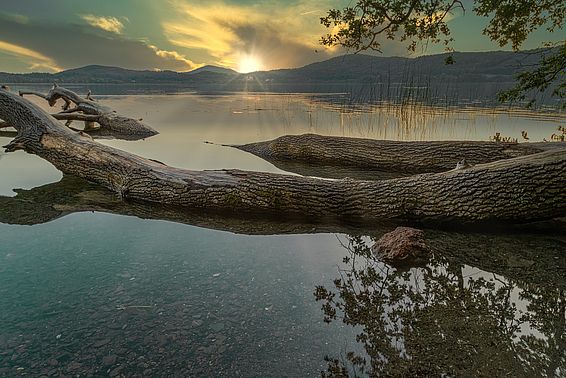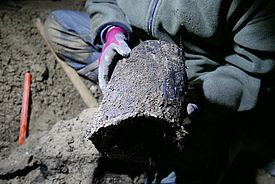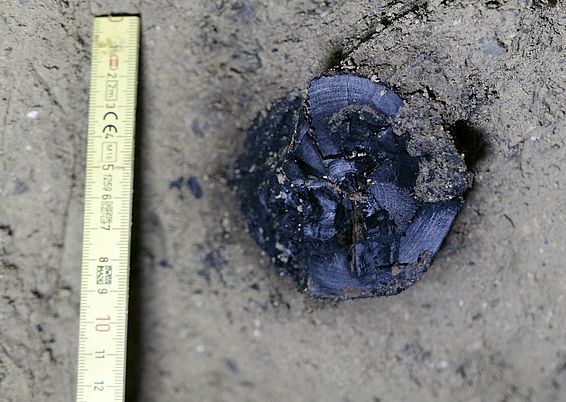30.06.2021 | WSL and Uni Mainz | News WSL
The Laacher See volcano erupted 126 years earlier than previously assumed, 13,077 years ago. This new dating provides decisive insights into climate fluctuations at the end of the last ice age. It was made possible, among other things, by the analysis of charred tree remains in the tree ring laboratory of the Swiss Federal Institute for Forest, Snow and Landscape Research WSL.
The eruption of the Laacher See volcano in the Eifel, Germany, is one of Central Europe’s largest eruptions over the past 100,000 years. The eruption ejected around 20 cubic kilometers of tephra and the eruption column is believed to have reached at least 20 km in height, comparable to the Pinatubo eruption in the Philippines in 1991. Technical advances and tree remains buried in the course of the eruption now enabled to accurately date the event. Accordingly, the eruption of the Laacher See volcano occurred 13,077 years ago and thus 126 years earlier than previously assumed. This sheds new light on the climate history of the entire North Atlantic and European region and requires an adaptation of the European climate archives. “We can use it to precisely date a drop in temperature at the end of the last glacial period, so that the information now coincides with that observed from the Greenland Ice Sheet cores,” says Dr. Frederick Reinig, a dendrochronologist at Johannes Gutenberg University in Mainz (JGU), Germany. An international research team with experts in archeology, climatology, ecology, radiocarbon dating, and volcanology was involved in this study. The research results were published in the renowned scientific journal Nature.
Charred remains of birch and poplar wood have been preserved to this day ¶
The eruption of the Laacher See volcano was a natural disaster that affected large parts of Europe. The ash rain reached as far as northern Italy in the south and Saint Petersburg in the Northeast. In the immediate vicinity and the neighboring Rhine Valley, mighty deposits of ash and pumice formed, which buried all life beneath them. “During the eruption, pyroclastic flows buried the local vegetation around the Laacher See volcano. The trees were partially charred within the ash deposits and have been preserved to this day,” says Prof. Dr. Paolo Cherubini a Senior Scientist at the Swiss Federal Research Institute for Forests, Snow and Landscape WSL in Birmensdorf, describing the eruption process that took place in late spring to early summer and probably lasted for several weeks - and which now enables scientists to precisely date the event. “These wooden contemporary witnesses are very rare, and they are difficult to recover,” says Cherubini, co-author of the study.
“The regional effects of the volcanic eruption have been well studied. What we have been missing so far is the certainty of when exactly this happened,” explains Prof. Dr. Ulf Büntgen, co-author of the Nature publication from the University of Cambridge. This was now determined based on samples from buried birch and poplar trees.
The analysis of tree rings at WSL and ETH reveals a precise date of the eruption ¶
The volcanic sediments not only preserved the wood for over 13,000 years but also allowed to identify the individual tree rings. “The tree rings enable us to exactly determine the age of the samples,” says Daniel Nievergelt from the WSL. In a WSL funded initiative, both newly discovered samples and older finds were analyzed at the WSL tree-ring laboratory. Additionally, the Laboratory for Ion Beam Physics at ETH Zurich carried out 157 high-resolution radiocarbon measurements. The calibration of these results against a Swiss radiocarbon reference then yielded the precise dating. "The constant advances in radiocarbon measurement technology and calibration, as well as the careful handling of the sensitive samples were key to establishing this dating result with an uncertainty of less than ten years," said Lukas Wacker from the ETH.
This study is based on a continuous research effort between the WSL and ETH which focuses on the Late Glacial period. The unique discovery of well-preserved subfossil pines from the greater Zurich area marks one of the world's largest and oldest finds of its kind. In recent years this collaboration resulted in the establishment of a Swiss Late Glacial archive with so far unpresented temporal precision. The link to the Laacher See Eruption and its improved dating is now the latest application of this endeavor.
Revised dating of the eruption has consequences for the synchronization of European climate archives and the understanding of large-scale climate dynamics ¶
According to the description in Nature, the eruption of the Laacher See volcano took place 13,006 years before 1950, with an uncertainty of 9 years. That is 126 years earlier than the generally accepted dating based on sediments in the Meerfelder Maar from the Eifel region in Germany.
This difference has far-reaching consequences for the synchronization of European climate archives and understanding of the North Atlantic and European climate history. Laacher See Eruption ashes were widespread over large areas of Central and Northern Europe as a result of the volcanic eruption and represent an important time marker for paleoenvironmental archives. Due to the new dating, the European archives now have to be temporally adapted. At the same time, a previously existing temporal difference to the data from the Greenland ice cores was closed.
This means that the massive cooling at the beginning of the Younger Dryas - the last Ice Age "Intermezzo", which lasted around 1,300 years, before the currently prevailing warm phase, the Holocene - also occurred in Central Europe 130 years earlier, around 12,870 years ago respectively. This is in line with the onset of the cooling in the North Atlantic region identified in ice cores from Greenland. During the Younger Dryas period, the last cold phase before the current warm phase, temperatures in Central Europe fell by up to 5 degrees Celsius. This strong cooling did not take place time transgressive, as previously thought, but rather synchronously over the entire North Atlantic and Central European region," says Frederick Reinig. The results of the interdisciplinary research team not only set a precise date for the eruption of the Laacher See in the Eifel. The revised age of the ash deposits and the associated shift in the European climate archives now sheds new light on the climate history of the entire North Atlantic region.
Contact ¶
Dr. Frederick Reinig und Prof. Dr. Jan Esper
Klimatologie, Geographisches Institut, Johannes Gutenberg-Universität Mainz
Tel. +49 6131 39-36083
E-Mail: reinig@geo.uni-mainz.de
Links, documents, video ¶
-
Precise date for the Laacher See eruption synchronizes the Younger Dryas DOI 10.1038/s41586-021-03608-x
- Subfossile wood found in Zurich, Switzerland
- Research group "Dendroscience" at WSL
Copyright ¶
WSL and SLF provide the artwork for imaging of press articles relating to this media release for free. Transferring and saving the images in image databases and saving of images by third parties is not allowed.




